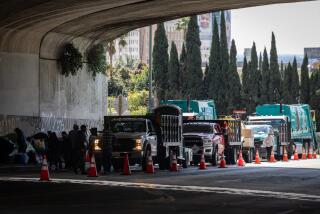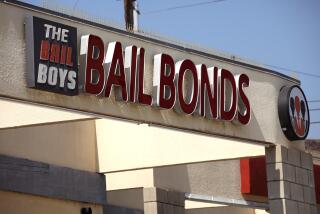California voters want more state services but resist tax increases
In the pages of one day’s Times last week were two in a lengthening procession of articles explaining what happens when governments run out of money, as city and county officials across the state cut programs to save cash. Four pages earlier was the kind of story that keeps them awake at night as they slice.
“Files detail deaths of 14 children.”
The article, based on documents obtained by The Times, outlined, hauntingly, the demise last year of 14 children killed by abuse and neglect in families that had been under the scrutiny of Los Angeles County child welfare officials.
Elected officials asserted they were shocked. No one else could have been. The county has seen those sorts of headlines before. And still, funding for its child welfare program lags.
The favored caseload for a social worker nationwide is 12 to 15 children. In Los Angeles County, each handles 20 to 35. The Department of Children and Family Services says it would take a boost of about $150 million a year -- a little less than 10% of its current budget -- to “effectively reduce caseloads.” Which is why the betting is that it won’t happen.
True, not every problem is solved by throwing money. Even truer, government agencies can make the most supportive of souls wonder if it’s all scaremongering. That is especially true when, as also happened last week, the Legislature brays that the sky is falling even as it tries to raise the salaries of its own aides.
But at bottom, the events of the last week were a reminder of the ever-shrinking options in a state where people just don’t want to finance a bigger government. When the bottom falls out of the economy, both the social workers and the government officials in charge of cutting programs are caught in the same net.
For years the Los Angeles Times Poll asked voters whether, to solve a pressing fiscal disaster, they preferred to raise taxes, cut programs or do some of both. Some of both carried the question, year after year. But when the hypothetical becomes real life, the answer is not that simple.
Darry Sragow ran Democratic campaigns in California for years, most notably for Assembly Democrats and a handful of Los Angeles school bonds. The Los Angeles lawyer said the experience was a reminder that, despite our national reputation as liberal loons, the state is actually populated with libertarians who share the view, regardless of party, that government is suspect.
“There is just a sense that government wastes money and does stupid things and therefore we ought to starve it,” he said, recapping views expressed at uncounted focus groups.
That has both caused and been reaffirmed by 40 years of government-bashing at the federal level. As Sragow points out, two of the Republican presidents who castigated government, Ronald Reagan and Richard Nixon, were Californians who came by their views naturally and spread them.
“A whole generation has heard that over and over again; it’s a very California message,” he said.
Sragow hastens to add that those who object to government are not endorsing, say, the deaths of 14 kids.
“There’s no one who says ‘I refuse, I will not pay more taxes and too bad 14 kids got lost in the . . . system,’ ” he said. They are, rather, screaming for more efficient programs that leave their taxes alone, whether that is possible or not.
The Field Poll, which has been measuring public opinion for decades, published an illuminating survey last year on the 30th anniversary of Proposition 13, the initiative that curtailed property tax hikes and cemented California’s anti-tax image nationally.
When voters were asked if they wanted government to provide more services, they assented, 61% to 30%. But when they were asked if they would like more services “even if it means raising your taxes and fees,” support plummeted and voters were split 44% to 40%
“It’s not all that changed from where we stood on taxes in the early ‘80s or late ‘70s,” said Mark DiCamillo, director of the Field Poll. In that time, he noted, “the state has become much more Democratic, yet its views on taxation have been consistent.”
Practically speaking, though, voters are not always completely realistic about the budget options. Much of the government’s budget at the state and local level is tied up in programs that are required by court order, federal mandate or -- particularly in California -- the voter initiatives that claim money for specific programs.
Many voters, as DiCamillo said, assume that “if someone was a hard taskmaster,” the state could save the billions that are now in the deficit column. “Most rational observers say that’s impossible, but that’s the public’s view,” he said.
The other problem is that many of the budget items that legally can be cut involve jobs and services that the public demands -- DMV workers, cops, teachers, social workers.
“It sounds nice to say, ‘Well, cut the bureaucrats who file their nails all day long,’ but that’s not the reality,” said Sragow. “The reality is that many of those people who get cut are providing services to the people.”
Los Angeles is hardly alone. In Yolo County, near Sacramento, officials were wrestling with cuts that amount to a third of the county general fund. The Sheriff’s Department -- its slogan is “Service Without Limitations” -- predicted massive cuts in patrols.
There as here, revenues are drying up and voters are uninterested in parting with more of their money.
“There is no good answer,” Sragow said.
Each Sunday, The Week examines one or more of the previous week’s major stories and their implications for our state or our region. Previous editions of The Week are archived online at latimes.com/theweek.
More to Read
Start your day right
Sign up for Essential California for news, features and recommendations from the L.A. Times and beyond in your inbox six days a week.
You may occasionally receive promotional content from the Los Angeles Times.







